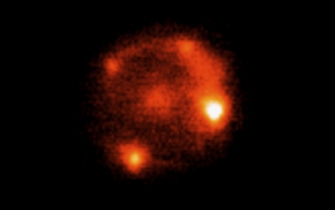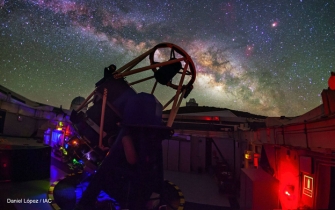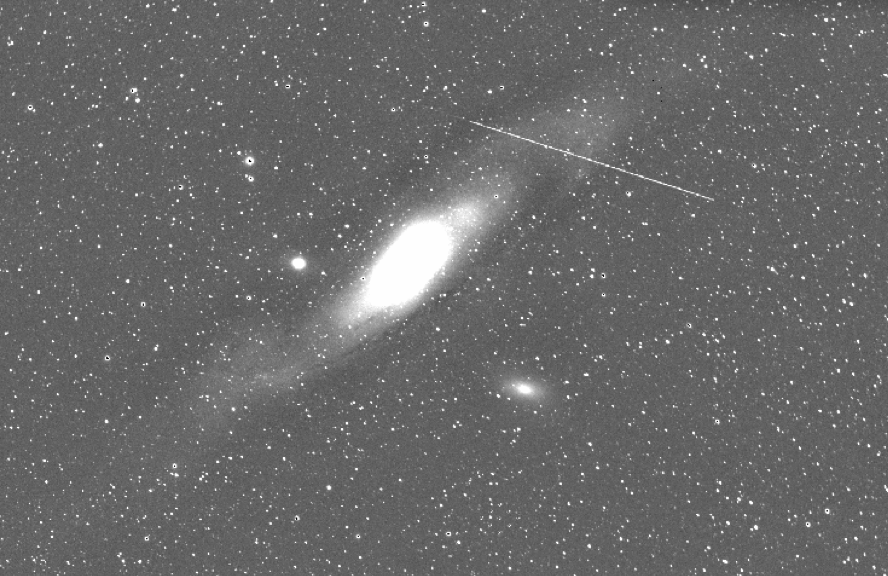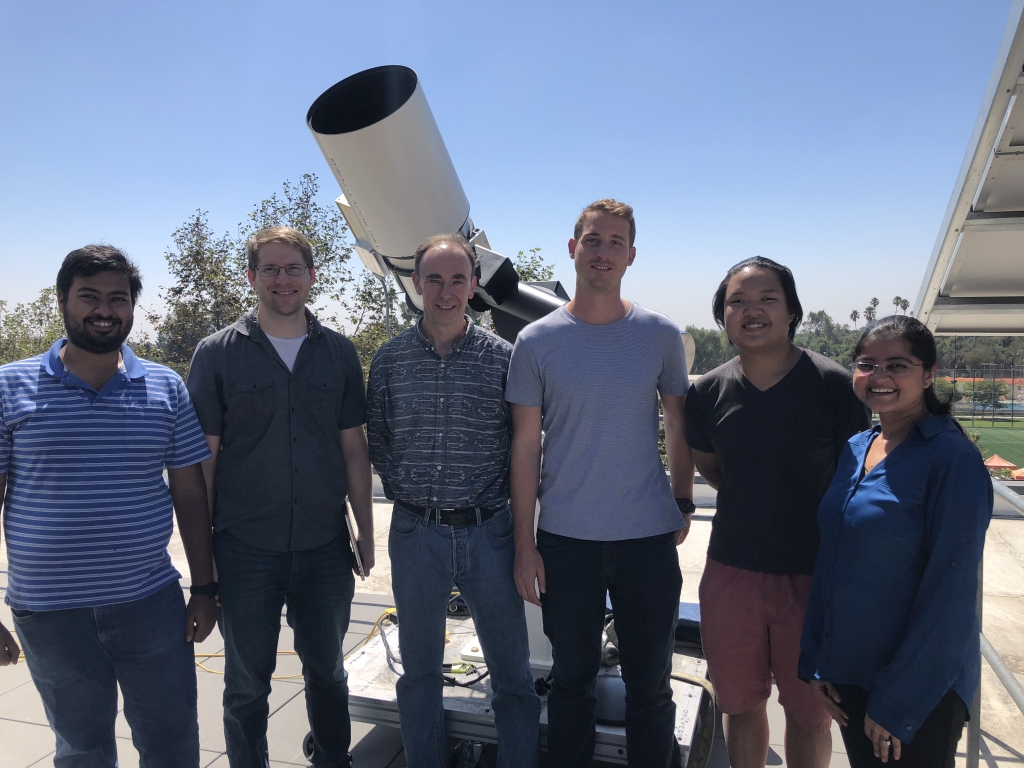
Gattini-IR is a novel wide-field infrared telescope at the Palomar Observatory designed to map the visible sky every night in search of transient events. Image credit: Scott Adams
2018
15 OctA new telescope for infrared celestial cinematography
A novel infrared telescope called Palomar Gattini-IR has begun scanning the universe from the Palomar Observatory in southern California. Gattini-IR will map the entire northern sky every night in search of cosmic explosions called novae, massive stars collapsing into black holes, and neutron stars merging with black holes.
The new infrared camera can scan 25 square degrees of the night sky all at once. This is an area that covers 125 times that of the moon and is 42 times larger than what can be achieved with current infrared cameras.
“Exploring the dynamic infrared sky should unveil a treasure trove of astrophysics. Yet the infrared window has remained largely shut,” says Mansi Kasliwal, an assistant professor of astronomy at Caltech who has designed and built the telescope in collaboration with Anna Moore, professor of astronomy at the Australian National University. “Palomar Gattini-IR should allow us to observe the violent universe in infrared at time-scales that were not possible before.”
Two main challenges slow down the infrared exploration of cosmic transients, fast-changing events that produce short-lived flashes of light lasting from a few hours to a few months. The first one is our own atmosphere which is glowing in infrared 250 times brighter that in optical. Imagine how many fewer objects you would see if the light pollution in your town increased 250-fold! As a result, most infrared probes that study the universe have to be sent to space, which comes at a much higher price that building a facility here on earth.
The second challenge is the high cost of infrared detectors compared to their ubiquitous optical counterparts, CCDs.
While not much can be done to solve the first challenge except to take telescopes higher up or into space, the Palomar Gattini-IR team has managed to tackle the second problem.
“We apply clever image processing algorithms to make sure we use the minimum possible number of detectors, therefore reducing the overall cost of the survey,” says Kishalay De, who leads the software development for Palomar Gattini-IR. “We also work with collaborators in Israel to develop efficient new algorithms to process data from the telescope.”
The commissioning was completed last month, and science operations began last week. The telescope is fit with robotics that allow it to scan the visible northern sky every night.
“We've automated the entire system to record a thousand images covering the entire night sky without any human intervention every night."- says Scott Adams, a postdoctoral fellow at Caltech who is part of the Palomar Gattini-IR team. "This unprecedented view of the dynamic infrared sky will help us understand better astrophysical phenomena ranging from the pulsations of bloated giant stars to explosions from stellar mergers."
One nagging question that astronomers have is how clouds of dust can form in the vicinity of violent nova explosions. Gamma-ray emission observed in these transients can only be produced when ejected material from the explosion collides with other material surrounding it, resulting in a shock wave. Supported by an award from the Research Corporation of Science Advancement, Kasliwal, who teamed up with Jeniffer Sokolski from Columbia University, will use data from Gattini-IR to peer through the messy environments around novae in our Galaxy in search of an answer to this mystery.
“In addition to letting us see thought clouds of dust, infrared light can tell us a lot about the formation of heavy elements in neutron star mergers such as the one we observed last year,” says Prof Anna Moore, co-investigator of the Palomar Gattini-IR project. “We also expect that collisions of neutron stars and black holes will shine brightest in infrared”.
Back in August 2017, alerted by LIGO, astronomers observed the first confirmed neutron star-neutron star merger, dubbed GW170817. While GW170817 lit up at all wavelengths, it was the long-lived infrared radiation that provided the first evidence that heavy elements such as gold and platinum are synthesized in such mergers.
“We learned a lot with GW170817, but many questions remain,” says Kasliwal. “Gattini-IR is a pathfinder to more ambitious projects that will allow us to answer questions such as: Which heavy elements are synthesized in mergers of neutron stars, and how much of them? Which elements are synthesized in mergers between neutron stars and black holes? What are the properties of the explosion in such mergers?”
Kasliwal speaks of WINTER and DREAMS. Funded under the Major Research Instrumentation program of the National Science Foundation, WINTER (Wide-field INfrared Transient ExploreR) will be a 1.13 square degree infrared camera whose sensors will be based on novel technology that can reduce its overall cost. WINTER will be built in the lab of Prof. Rob Simcoe from the Massachusetts Institute of Technology, who leads this project, while Kasliwal’s team will develop the software for the operations and data processing once WINTER is mounted on a new 1-meter telescope at the Palomar Observatory.
To observe the southern sky, Moore and Kasliwal have proposed the southern counterpart of WINTER - a 3.75 square degree infrared camera called DREAMS (Dynamic REd All-sky Monitoring Survey). If funded, DREAMS will go on a 0.5-meter telescope at Siding Spring Observatory near Coonabarabran, New South Wales, Australia.
WINTER and DREAMS should be ready to scan the skies around 2020 when the LIGO-Virgo observatory will run its 4th cycle of observations.
Palomar Gattini-IR is funded by Mt Cuba Foundation, RCSA Scialog award, United States-Israel Binational Science Foundation grant, as well as Caltech and Australian National University funds awarded to Kasliwal and Moore.
Related Links
Unveiling the Dynamic Infrared Sky with Gattini-IR
Are novae dusty cosmic cataclysms?
Orbital Path 2: The most dramatic sky
Contact
Iva Kostadinova
Communications Manager
ivonata@caltech.edu
+1 626 395 2952
Science Contacts
Mansi Kasliwal
Assistant Professor of Astronomy, Caltech
mansi@astro.caltech.edu
+1 626 395 1575
Anna Moore
Professor, Australian National University
Anna.Moore@anu.edu.au






